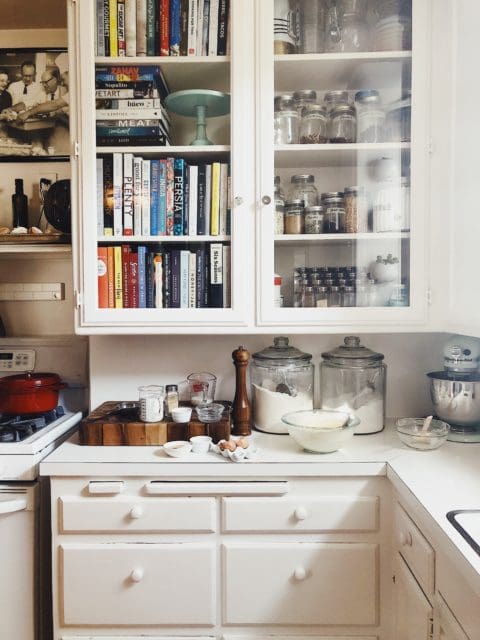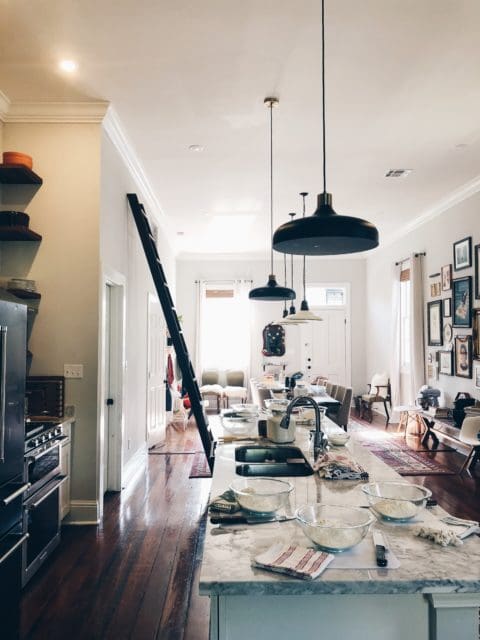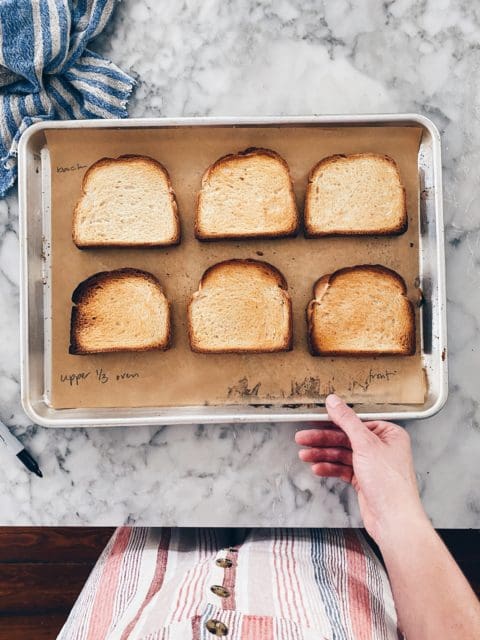Welcome to the wonderful world of baking where flour, butter, and our collective sweet tooth’s (teeth? teeth’s??) come together to create an absolute mess in our kitchens. Dirty every dish, I say! In the name of cookies, of course. Whether you’re a seasoned baker, or just tying up the apron strings for the first time, knowing how to read a recipe is one of the most crucial steps in your baking success.
It’s easy to take for granted exactly how to read a recipe. There’s a lot of nuance in the structure of each recipe we encounter and I want you to know the ins and outs. A well-written recipe is invested in your success; you just have to know how to decode it.
Let’s roll it all the way back to basics. Let’s get on the same page, namely page 147 of Erin Jean McDowell’s Savory Baking.
1. Read Through the Recipe
First of all, I understand this is like reading the instruction manual to the appliance you’re already pretty sure you know how to work. Who does that? Barely anyone. Just humor me and, before you start creaming butter and sugar, read through the entire recipe. Honestly, I’d settle for an intentioned scroll through the text. Believe me.
Reading a recipe from beginning to end is a big deal. The instructions may have some hidden ingredients (like water, for example), or split the ingredients within the list in an expected way (like using one egg for batter and one for an egg wash). You want to know the lay of the land before you start throwing things in a bowl. Read the dang recipe thaaaaanks!
2. Understand the Ingredient List
A recipe’s ingredient list is detailed in the order the ingredient will be used! Not only is the recipe list a very helpful shopping list, but it also gives you insight into how the recipe will come together.
In Erin’s recipe above, for example, we know that bread flour is the first ingredient, followed by sugar, yeast, and salt. Without even looking at the instructions, we can gather that we’ll whisk sugar, yeast and salt into the flour in that order. But hey, we’re not assuming anything. Refer to step 1. We’re reading the recipe.
3. Mind the Comma
You’ll notice that many ingredients in the recipe list are followed by a comma and a direction. Pay attention to what happens after that comma.
After the comma you’ll generally find an instruction in regards to an ingredient’s temperature (like melted or at room temperature) or an action (like chop, mince, or dice) that needs to befall the ingredient. Every cut, chop, dice, and melting instruction after a comma in an ingredient list is to be done after the ingredient is measured.
For example: 2 garlic cloves, minced and 6-ounces hot-smoked salmon, coarsely crumbled
The absence of a comma is also revealing. For example: 3/4 tablespoon finely grated parmesan cheese and 3 tablespoons finely chopped capers
The absence of a comma mean the action (like grating or chopping) takes place before the ingredient is measured.
4. Pack, Soften, and Preheat: The Devil in the Details
Recipe lists often request that brown sugar be “packed”. Take the back of a spoon and firmly (but not totally Hulk-style) press the sugar into the measuring cup. Add more sugar and pack until sugar is flush with the top of the measuring cup. If the recipe indicates grams versus volume measurements – you’ll have a precisely measurement of a packed cup of brown sugar.
Soften butter by allowing it to rest at room temperature for about 1 hour. Don’t cheat yourself or the butter by not allowing the butter to soften before combining it with sugar and eggs. The temperature of ingredients is key when it comes to baking.
Preheat the oven. Yeasted dough hates a 200 degree F oven but sure does love a 325 degree F oven. Again, temperature is a big deal!
5. Is It Done Yet!?
Doneness is recipe instructions are usually described by a time range and visual cues.
For example: Bake 55 to 65 minutes, until rolls are lightly browned; they should have an internal temp of 190 degrees F.
I typically set my timer for 5 minutes below the lowest indicated time. Just in case – you can’t take back an overbake. Use time, looks, and temperature to decide if your baked goods are done. With practice, you’ll be able to smell exactly when a recipe is done. It’s wild!



More in the Baking 101 Series:
My Top 5 Fall Baking Tips because we could all stand to freshen up our baking powder.
My Top 15 Kitchen Splurges That Makes My Time in the Kitchen So Much Better from linen aprons to bench scrapers and a very nice wooden rotating tray.
How To Test Your Oven With Toast so, grab some butter because we’re about to have toast for lunch.
245 Responses
2 C sifted flour = you sift before measuring
2 C flour, sifted = you sift after measuring correct
Yes, that is correct!
hello samantha from 2015 i am replying to your words in 2025 im sorry I’m late! do you know who won the superbowl in 2016 yet. the Panthers lost
why receipts do not give temps for when it is done 190 for bread etc.
Thanks for the great post! May I print and distribute to my high school “healthy foods” class?
sure!
Will adding an extra egg to a pound cake recipe make it lighter or denser?
I think it would make it more dense. That’s what I think!
It will make it denser.
You’re so funny! Love reading your posts!
Thanks JOY!
How about the timing of baking cookies when the recipe doesn’t specify the type of baking sheet? I like to bake on parchment paper to get a clean cookie off the sheet rather than one where the bottom is a little messed up from the spatula. When I bake on shiny sheets with parchment paper it takes longer to bake as compared with a darker tray without parchment paper. Also, when should you bake in a convection oven and how does that affect the end product and how does that affect the baking time? I appreciate your knowledge and advice.
These are all good questions, I will write a blog post on it.
How to write a recipe …
It drives me crazy when amounts for some things are in volume measure, and for some they’re in unspecified “ounces”. It would be much better to state “weight ounces” as the counterpart to “fluid ounces”, and never leave it unspecified.
This was the most informative and fun website I have ever visited. It me gave so much needed information in a fun way. I just kept on reading and learning things about recipes that I never knew before. I will tell all friends so they can visit and learn as I did.
This was awesome, Joy! (And, funny!) My takeaway is to #RespectTheComma. Thanks for sharing!
Yess hahaa
This was a needed article- we rush in and think we got this and after a reread to find out we missed this or that. Even us old cooks who know better will find ourselves not taking time to read and understand the recipe sometimes. I make myself slow down and find a comfortable chair and quietly read through the recipe. Then go through the cabinet and pull out the ingredients- so often I’m sure I’ve got that and I don’t.
I hear you, Debra! I find myself needing to take my own advise more often than I care to admit. :)
This is such a timely and much needed post. I find with blogging being so popular there are a lot of bloggers out there who are talented (and often merely capable – almost) of baking, sewing, etc. but are not capable of writing a recipe or pattern in the correct way.
Great information! especially the coma info.